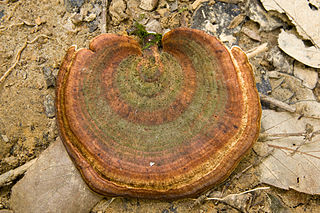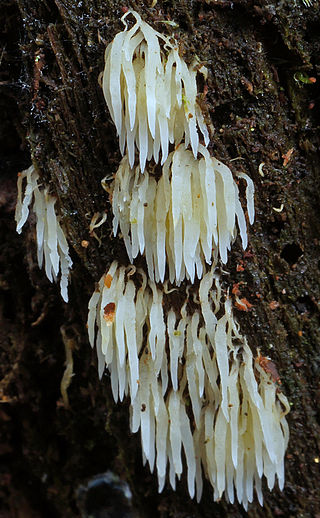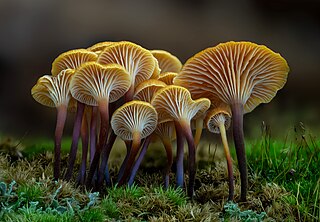
The Russulales are an order of the Agaricomycetes,. According to the Dictionary of the Fungi, the order consists of 12 families, 80 genera, and 1767 species. According to Species Fungorum, the order contains 13 families, 117 genera, and 3,060 species.

Endogonales is an order of fungi within the phylum of Zygomycota, and in class Endogonomycetes.

Paurocotylis is a genus of fungi in the family Pyronemataceae. The genus contains multiple species, with the most well known being Paurocotylis pila, a truffle-like fungus found in Europe and New Zealand. It was described by Miles Joseph Berkeley in 1855. Species found in countries other than New Zealand include P. watlingii, P. singeri, P. prima, P. patagonica, P. niveus, P. echinosperma and P. bynumii.

Pseudocolus fusiformis is a stinkhorn mushroom in the Phallaceae, a family well known for a remarkable range of fruit body types. It is commonly known as the stinky squid, because of its fetid odor, and its three or four upright "arms" which are connected at the top. The malodorous smell comes from the dark greenish slimy gleba covering the inside faces of the arms, and attracts insects that help to disperse the spores.

Arachnion is a genus of gasteroid fungi in the family Agaricaceae.

Disciseda is a genus of gasteroid fungi in the family Agaricaceae. It is a widely distributed genus that is prevalent in arid zones. Disciseda was circumscribed by mycologist Vassiliĭ Matveievitch Czernajew in 1845.
Secotium is a genus of fungi in the family Agaricaceae. The members of this genus are closely related to ordinary Agaricus mushrooms, but do not open out in the usual way; this has given rise to the term "secotioid" for such mushrooms in general. They are thought to form an evolutionary link between agarics and gasteroid fungi. Secotium is a widespread genus, with species that are predominantly found in warm and arid regions.

Irpex is a genus of corticioid fungi in the order Polyporales. Species produce fruit bodies that grow as a crust on the surface of dead hardwoods. The crust features an irpicioid spore-bearing surface, meaning it has irregular and flattened teeth. Irpex is distinguished from the similar genera Junghuhnia and Steccherinum by the simple septa found in the generative hyphae.

Diplomitoporus is a genus of fungi in the family Polyporaceae. The Dictionary of the Fungi estimated the widespread genus to contain 11 species; since then, the genus has grown with the additional of several newly described species, and some transfers from other genera. Diplomitoporus has been described as a wastebasket taxon, containing "species that share common macroscopic and microscopic characteristics, but are not necessarily related."

Favolus, or honeycomb fungus, is a genus of fungi in the family Polyporaceae. The fruit bodies of Favolus species are fleshy with radially arranged pores on the underside of the cap that are angular and deeply pitted, somewhat resembling a honeycomb.

Lopharia is a genus of fungi in the family Polyporaceae. The genus was circumscribed by Károly Kalchbrenner and Peter MacOwan in 1881.

Microporus is a genus of fungi in the family Polyporaceae. The genus has a widespread distribution and, according to a 2008 estimate, contains 11 species. The genus name combines the Ancient Greek words μικρός ("small") and πόρος ("pore").

Spongipellis is a genus of fungi in the family Polyporaceae. The genus is widely distributed and contains ten species. The genus was circumscribed by French mycologist Narcisse Théophile Patouillard in 1887. The genus name combines the Latin words spongia ("sponge") and pellis ("skin").

Mucronella is a genus of fungi in the family Clavariaceae. Species in the genus resemble awl-shaped teeth that grow in groups without a common subiculum.

Xeromphalina is a genus of fungi in the family Mycenaceae. The genus has a widespread distribution, and contains about 30 species.

Gallacea is a genus of fungi in the Gallaceaceae family. The genus contains six species found in Australia and New Zealand. Gallacea was circumscribed by American mycologist Curtis Gates Lloyd in 1905.

Serpula is a genus of fungi in the family Serpulaceae.
Dingleya is a genus of truffles in the Tuberaceae family. The genus contains seven species found in Australia. Circumscribed by James Trappe in 1979, the genus is named after New Zealand mycologist Joan Dingley.

Ductifera is a genus of fungi in the order Auriculariales. The genus is widespread, especially in tropical regions, and contains about 11 species. The genus was circumscribed by American mycologist Curtis Gates Lloyd in 1917.
Nothocastoreum is a fungal genus in the Mesophelliaceae family. The genus is monotypic, containing the single truffle-like species Nothocastoreum cretaceum, found in Australia.

















